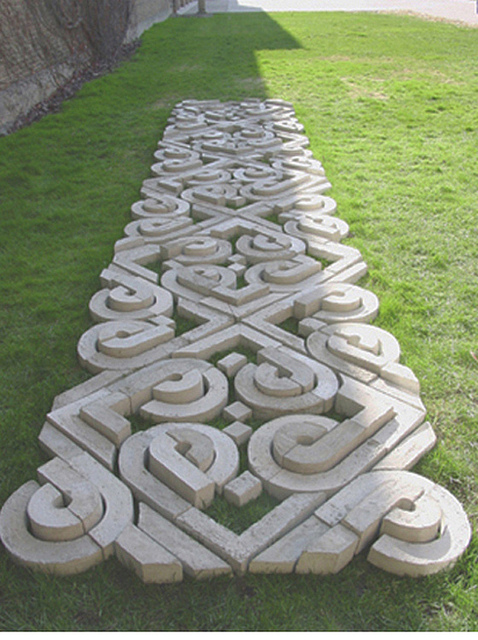
Artist Rachel Miller Brings Together Environment, Travel, Textiles, Nature and More
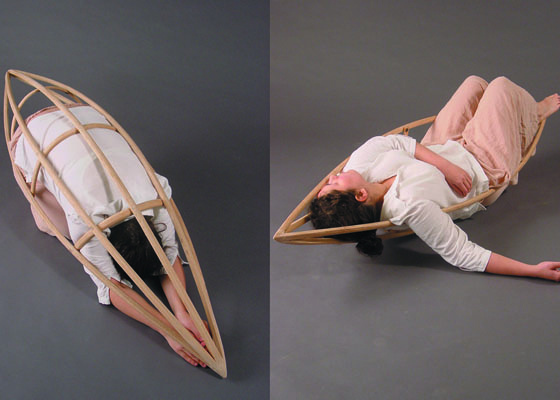
Drift, Materials: bent-laminate oak
Rachel Miller‘s work focuses on environmental patterns and how they interconnect with our own patterns of growth, departure, and rejuvenation. Using both the body and landscape as cynosure and subject, she coalesces topics from ritual, archeology, architecture, travel, textiles, and nature. Her works, which include sculpture, installation, performance and costume, examine the constant resurfacing of the past, and its integration with the present.
Eco Chick: How did you come to create environmentally-focused art?
Rachel Miller: My environmentally-focused work began by walking in nature and observing environmental patterns. I have always thought of pattern as a metaphor for the journey of life, consistent and transient in rhythm and movement. Instead of viewing the journey of life as a sad thing, I see it as a moment of reflection and recognition within myself. I view it as a way of seeing the world. Although patterns are historically seen in textiles, I view pattern as a journey, a sculptural category that shifts, resurfaces, and recedes through time and space, and the ground beneath us.
In turn, my work is a lifecycle, spiritual and physical. I choose materials that specifically have a lifecycle. I use materials that can and do biodegrade, because it is about life cycle. Its journey of transformation reflects what I find within nature itself— a consistent pattern of memory, experience, and closure.
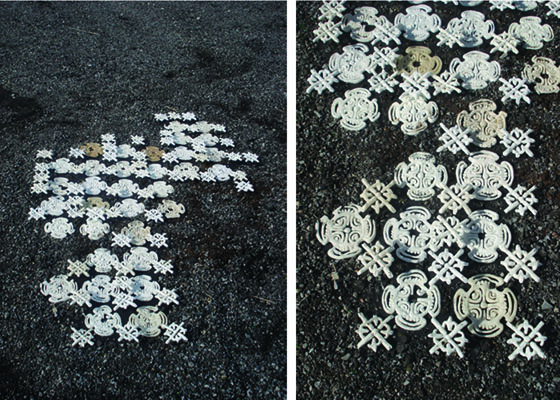
Consistence/ Transience: Installation at Fresh Kills Park, Staten Island, NY
Materials: sculpted soap
EC: Do you think there is such a category as “eco art”?
RM: I try to steer clear of categorizations as much as I can. To showcase artwork as specifically eco-art can place work in such a way where other important attributes of the work may go unrecognized. For instance, the materiality of a photograph may not be made of environmentally friendly materials, yet the subject matter may be about environmental concerns. So is the photo eco-art because of the subject matter, or is it not, because it was produced using a chemical process? Or, an installation may be created from recycled clothes, yet the subject matter could be about the complete opposite of recycling.
As for myself, my work is comprised of many things, and most of my materials can and do biodegrade, yet the transience of these materials also serve as a metaphor for the work’s content. I have been called a sculptor, installation artist, land artist, performance artist, or environmental fiber artist—I respond to work that can reach various dialogue and disciplines, and am happy that I am not categorized into just one aspect. It keeps me creative.
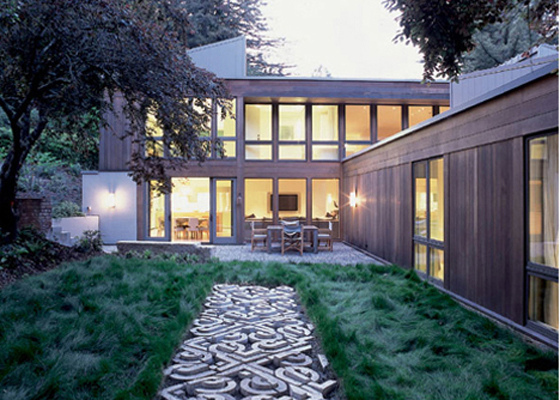
Passing II. Dimensions: 24 feet x 4.5 feet. Materials: cast concrete. Collection of Tsao McKown Architects. Photography by Eric Laignel, as featured in Interior Design Magazine article, “The Tsao Dynasty.” Issue: “The Naturals.” Additional images
EC: Are there environments or places that inspire you over and over again?
RM:I would have to say India. I was there as a visiting faculty to teach textile design and fiber arts to university students and do my own research. From the colors and textures of beautiful textiles, to the smells of organic matter and fuel, to the sounds of honking taxis and exotic birds, from the spiritual customs to the embrace of high technology, there was so much to take in! It is where I really experienced the rituals of life, death, and decay all embedded in the same moment– this is what compels me.
EC: How do you take a feeling or observation and turn it into a piece of art? What is your process?
RM:As I touched upon in the first question, my process is getting outside and walking. Lots of walking. So many things can happen from this act, like collecting fallen matter that I find along the way, or staring at a tree for hours, observing its movements. I dig, both metaphorically and at times physically into these observations and findings and I continue walking until I can find a place to be still in silence, and really look, hear, and feel what is happening around me, and the texture I feel beneath me.
It’s like having an exchange, a metaphorical conversation, if you will, as to how these surroundings “speak” to me. It could be the rhythm of wind currents, or observing growth patterns in a field of grass, or patterns of dried leaves scattered on the ground where pattern resides. From this, I think of the relation of pattern to the body, such as conscious to unconscious acts like blinking, breathing, using the same route to walk or ride to work— patterns are ever-evolving, always returning back to their point of origin. Then, I see and feel how patterns of my own body interact with my surroundings and look for these connections. In one of my works, “Breathing Field,” I explain this work like a pattern with action: The patterns of my own body interact with my surroundings. Branches sway, the body sways. Bones crack, limbs crack.
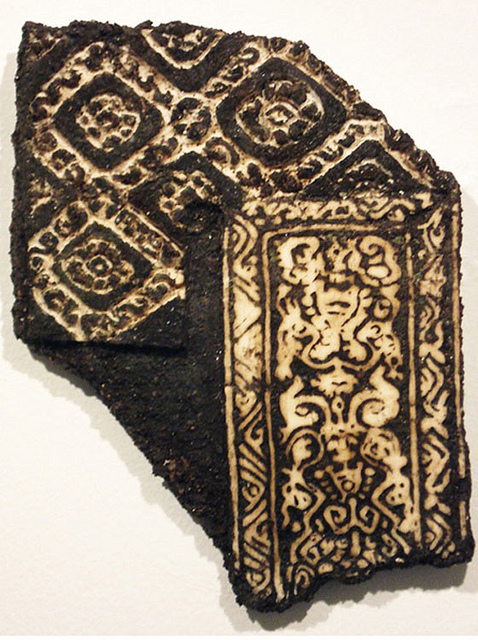
Mirror: Dimensions: 9.5” x 11.5”. Materials: dirt and soap
EC: How do you convey these ideas to students?
RM: I try to encourage my students to find their own methodology with how they create their work. I do instill my perspective, and share my knowledge of experience, and skills, however, one of the main themes I emphasize is for my students to find their own truth. I encourage them to explore what they are really passionate about, and then go for it from there. I am enthusiastic about my work, and I encourage them find what is that really drives them. I’m also big on documentation, whether it is writing, photography, or sketching.
I emphasize that creative process does not take place in a vacuum. For instance leaving the studio and exploring their surroundings, is critical for continued growth and fresh ideas. Learning about different cultures, learning the facts, constantly observing, staying focused and open, and always questioning are just a few things that I convey to my students.
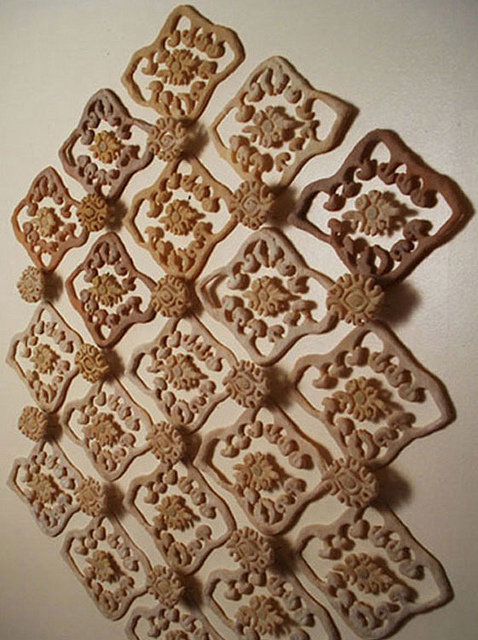
Untitled. Dimensions: 32” x 40”. Materials: latex
EC: Is there a way non-artists can tap into their creative energy? Any tools or resources to recommend?
With focus and work, I honestly believe that everyone can tap into his or her own creative energy. Call me an idealist, but I definitely think so. For starters, carrying a sketchbook or camera as much as possible, as ideas can come out nowhere and everywhere, are great portable resources. These tools can help people tap into discovering a lineage of themes that they never realized were of interest until the documentation process took place.
If people have a keen sense of what their routine and/or interests are, then it could be an unconsciousness message that there is something deeper that has yet to unfold in the creative sense. For instance, someone that is quite detail oriented and mathematical may find solace in learning a specific craft, such as woodworking, weaving, or architecture. Or someone that is drawn to touch and textures could develop an interest in sculpture or dance. These are just examples and may not be applicable to everyone, however, I can speak from personal experience that my curiosity and observations of nature from an early age, played a major role in inspiring and fueling my passion work with it as subject matter in my own process.
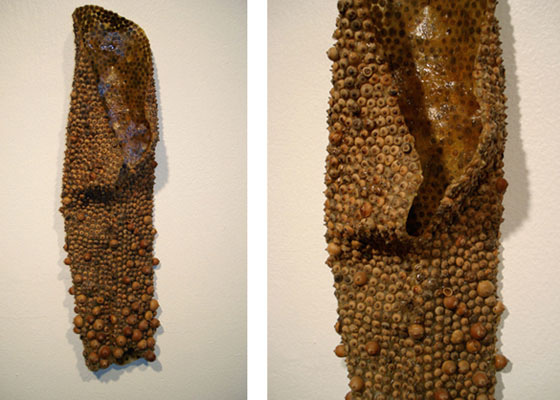
Sleeve: Dimensions: arm’s length. Materials: latex & seeds.
More About Rachel Miller: Concurrent with her studio practice, Miller designs and creates sets, costumes, installation, and sculpture, independently and for films, theatre, and dance. Her work has been featured in several theatres and exhibitions, including Gallery 125, Seoul, Korea; Teatro Communale, Citta della Pieve, Italy; Teatro Mancinelli, Oriveto, Italy; Museum of Arts and Design, NYC; PS 122, New York; Newark Museum, NJ; Rosalie Borowsky Gallery, PA; and the Cranbrook Museum of Art, MI.
She teaches and lectures at various institutions, including coursework in Sustainable Design in the Fashion Department at Pratt Institute, NY; the Enterprise Program in Sustainability at FIT in New York, and the Fiber Department at University of the Arts in Philadelphia. She has also worked in India, where she has done extensive research in addition to teaching textile design / fibers to university students. Her work has been featured publications such as Interior Design Magazine, Tribunale Firenze, and the Bengaluru Pages. She has also written for Hand/ Eye Magazine, NYC; and for the Museum of Arts and Designs’ educational publications.
Miller’s work has been published, commissioned, and reviewed internationally, and is included in both public and private collections. She currently resides and maintains her studio practice in Brooklyn, NY. www.rachel-miller.com
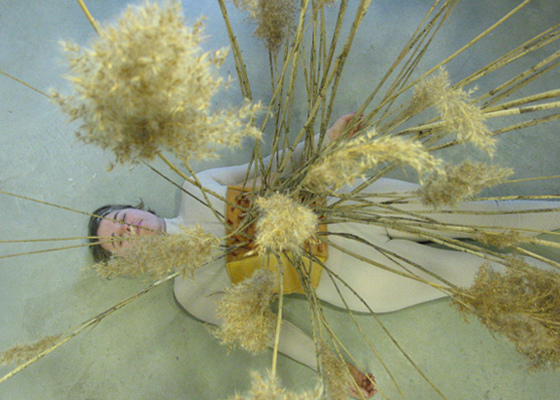
Surfacing (performance still) Materials: reeds, latex, copper. Photography by Vivian Beer
All Artwork and writing: Copyright Rachel Miller.


